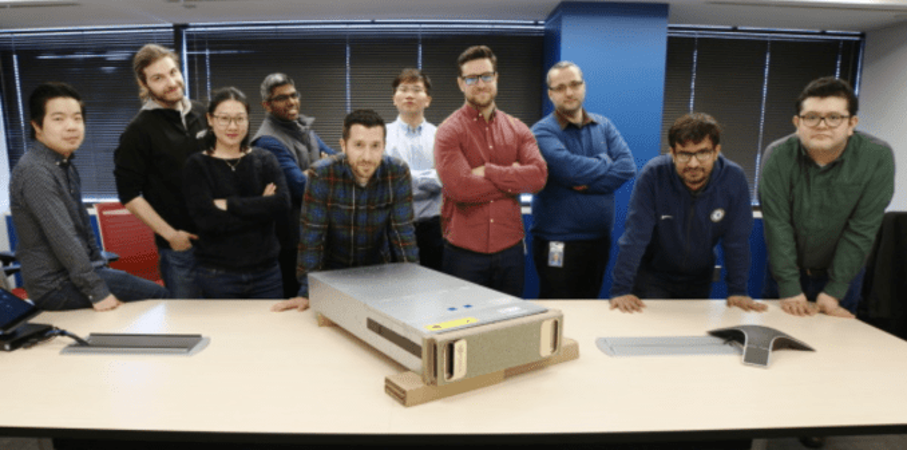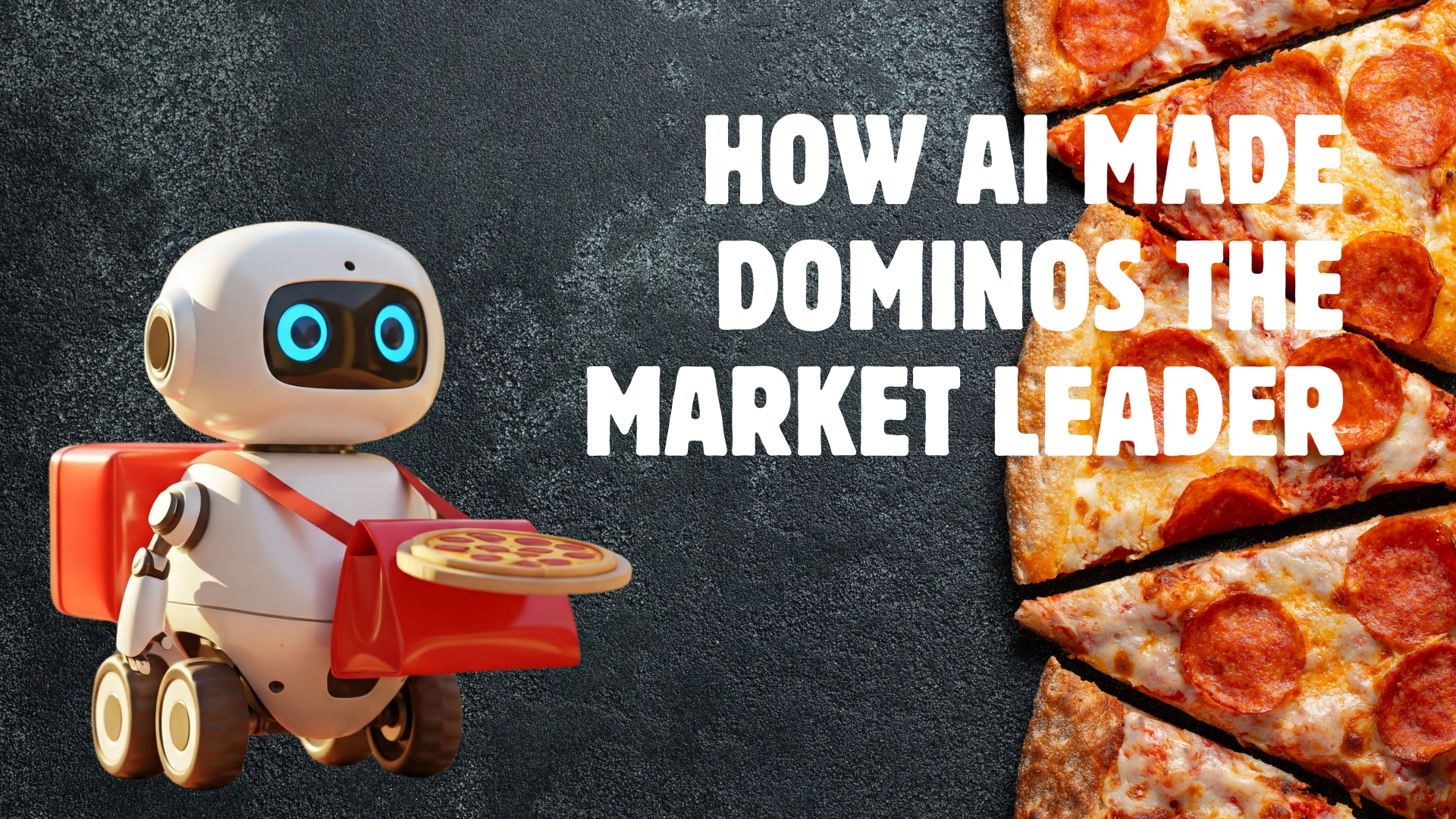A pizza or technology company?
Domino’s Pizza has transformed itself from a traditional pizza chain to a tech-driven giant, dominating the global pizza market. While once overshadowed by Pizza Hut and other competitors, Domino’s is now the world’s largest pizza company by revenue and store count. A major factor behind this success is Artificial Intelligence (AI), which has become a key driver in Domino’s operations, from optimizing delivery logistics to personalizing customer experiences.
Today Domino’s Pizza operates in more than 90 countries with over 19,000 stores worldwide.
Domino’s was one of the first pizza companies to heavily invest in technology, offering online ordering, an app with real-time tracking, and even experimenting with AI, drones, and autonomous delivery vehicles. Their tech-driven approach has contributed significantly to their market leadership.
Domino’s has consistently reported higher revenues than its closest competitors. In 2022, Domino’s generated over $4.5 billion in global revenue.
How AI played a pivotal role in Domino’s rise to the top
Domino’s delivery model has always been central to its identity. However, in today’s fast-paced world, merely having fast delivery isn’t enough. Domino’s leveraged AI to enhance their delivery systems, making them faster, smarter, and more efficient.
The super bowl commercial that changed the business
One pivotal moment in Domino’s history was a Super Bowl commercial Domino’s Pizza ran that focused on gathering consumer preferences in a fun and engaging way. They did this to gather data on what toppings their customers liked that they feed their machine with. They understood the value of great input and decided to do it with a big bang.
The super bowl public
For those not familiar with the Super Bowl it may be good to understand that the Super Bowl is one of the most-watched sporting events globally. In recent years, the Super Bowl has attracted around 100 million viewers in the United States alone. For instance, the 2023 Super Bowl had an estimated 113 million viewers, making it one of the most-watched broadcasts in U.S. television history. Worldwide, the number of viewers can vary, but it’s estimated that the Super Bowl garners over 150 million global viewers when considering international broadcasts and streaming platforms.
A massive audience equals a massive budget in this case but compared to other organizations marketing at the Super Bowl Domino’s had a strategy that generated a massive return on their investment not only in form of revenue but in data and eventually market leadership.
An inventive way to customer engagement and data collection
Domino’s launched a Super Bowl campaign asking viewers to share their favorite pizza toppings and preferences through a social media hashtag and interactive app.
They incentivized participation by offering discounts and special offers during the game, which led to an overwhelming response.
Feeding the machine learning (ML)
The data they collected through this campaign was not just used for marketing; it fueled their machine learning (ML) models. Domino’s ML models analyzed patterns in the data to optimize inventory, predict demand, and personalize recommendations for future orders. For example, by learning what toppings people loved most during a big event, Domino’s could prepare for higher demand in certain areas or stock specific ingredients in higher quantities.
The super bowl strategy
The Super Bowl is one of the biggest pizza-ordering events in the U.S., with millions of pizzas sold in just one day. Using machine learning to predict customer demand, Domino’s tailored their logistics to handle the rush more efficiently than competitors. Domino’s went from being a traditional pizza chain to a tech-driven company with sophisticated AI algorithms optimizing everything from delivery routes to customer experience on their app.
Further investments in AI
To improve the customer experience even further Domino’s introduced Domino’s Tracker, an AI tool that allows customers to monitor their pizza’s progress in real time, from preparation to the driver’s arrival at their door. This tracking not only improves transparency but also allows for better resource management.
Domino’s also invested in AI-driven tools that analyze traffic patterns, weather, and local conditions to optimize delivery routes, ensuring pizzas are delivered faster and fresher. The AI system continuously learns and adapts to real-time variables, making the entire process more efficient.
Personalized marketing with machine learning
AI has helped Domino’s tap into data to better understand and serve its customers. Through machine learning algorithms, Domino’s can analyze customer behavior and preferences, leading to more personalized offers and recommendations.
By studying past orders and preferences, Domino’s tailors promotions to individual customers. The AI system can predict what deals will most likely attract a customer back, whether it’s a specific pizza topping or a family deal at a specific time.
AI enables Domino’s to adjust pricing based on demand, location, and even customer loyalty. This dynamic pricing ensures that Domino’s can maximize profits while still offering competitive deals during peak times like the Super Bowl.
AI-driven inventory management
AI helps Domino’s optimize its supply chain and inventory by predicting demand more accurately.
During high-demand periods, such as holidays or events, Domino’s uses machine learning models to predict what ingredients are needed at different locations. This ensures stores are stocked with the right amounts of dough, cheese, and toppings, minimizing waste and maximizing efficiency.
Domino’s has integrated AI into their kitchen processes as well. For instance, AI-powered systems help manage oven temperatures, baking times, and ingredient ratios, ensuring that each pizza is cooked consistently across stores.
AI in enhancing customer experience
The Domino’s mobile app is a significant part of their tech success. AI plays a crucial role in making the app a user-friendly and interactive experience.
Domino’s introduced Domino’s AnyWare, an AI-powered voice recognition system that allows customers to order via smart speakers, text, social media, and even wearables. This system uses natural language processing (NLP) to understand customer orders accurately and streamline the ordering process.
AI systems help resolve common customer issues through chatbots, which answer questions, take orders, and even suggest meals based on previous purchases. These chatbots significantly reduce wait times and improve customer satisfaction.
AI-driven future for Domino’s
Domino’s continues to push the boundaries of innovation through AI, exploring technologies like drone delivery, autonomous vehicles, and even robotic pizza chefs. Their ability to leverage AI in all aspects of their business, from supply chain to customer experience, sets them apart as a customer experience company that happens to sell pizza.
Market domination
Over time, this AI-driven approach helped Domino’s significantly increase its market share. Domino’s is selling nearly 2 million pizzas on Super Bowl Sunday, solidifying their dominance in the market.
What a Domino’s employee says
Zachary Fragoso, a Data Science and AI Manager at Domino’s says:[1]
“I’m part of a team at Domino’s that’s delivering business results with the technology today. I won’t claim it’s easy, but I do know success is out there for people ready to do the work needed to master this emerging approach to computing. I hope our experiences can inspire others to experiment with AI in their business and figure out what works best for them.
Having a system to manage a model’s lifecycle greatly eased the transition from development to integration with our production platforms managed by our business partners. As a result of that work, Domino’s has been able to boost productivity. We train and iterate on AI models faster and get them deployed to inference systems at lightning speed, accelerating time to positive business outcomes.
The big challenge for us was integrating our AI-enabled microservices into our e-commerce and in-store platforms. The teams running these platforms have been keeping one of the largest global e-commerce sites running for decades.
The data was relatively new even if the team was experienced.
We had to learn about software development at scale. Our internal partners had to learn about model development cycles. With a little flexibility, both sides succeeded.
We have a diverse team at Domino’s, but we’re all united on the mission to make the customer experience and store operations better.”

Part of the Domino’s data science team with one of its NVIDIA DGX-1 servers
Key take aways
AI has been instrumental in transforming Domino’s from a pizza chain into a market leader and tech-driven powerhouse. By embracing AI, Domino’s has optimized its delivery, enhanced customer satisfaction, and increased revenue through smarter marketing and operations. As the company continues to innovate, it’s clear that their commitment to AI and technology will keep them at the forefront of the pizza industry for years to come.
Through the blend of machine learning, marketing, and logistics optimization, Domino’s became more of a tech company that just happens to sell pizzas, and their success on major events like the Super Bowl is a testament to the power of AI.
Although Pizza Hut had long been a dominant player with a larger number of stores historically, Domino’s tech innovations and streamlined delivery model helped them surpass Pizza Hut in revenue and store growth, solidifying their position as the largest pizza company in the world.
Domino’s AI success story: Super Bowl domination
One of Domino’s most remarkable AI-powered successes is their dominance during the Super Bowl, one of the biggest pizza-ordering days in the United States. Through clever use of AI Domino’s uses machine learning models to predict customer demand down to the specific pizza toppings that will be ordered most frequently on Super Bowl Sunday. This allows them to prepare the right amount of ingredients, avoiding stockouts or surpluses. Domino’s also created an innovative Super Bowl commercial, inviting viewers to share their favorite toppings and preferences via social media. This crowdsourced data fueled their AI models, providing insights into consumer behavior and trends, which helped them fine-tune future campaigns. Domino’s AI capabilities allow the company to handle the immense surge in orders on Super Bowl Sunday efficiently. Thanks to AI-driven operations and logistics, they’re able to sell around 2 million pizzas on this day alone, outperforming their competitors in both sales and delivery times.
Would you like to learn how to leverage AI
to drive business benefits just like Domino’s?
[1] https://techcrunch.com/sponsor/nvidia/how-ai-helps-dominos-predict-when-3-billion-pizzas-are-ready-to-go/


